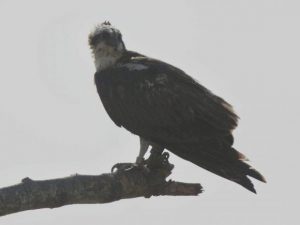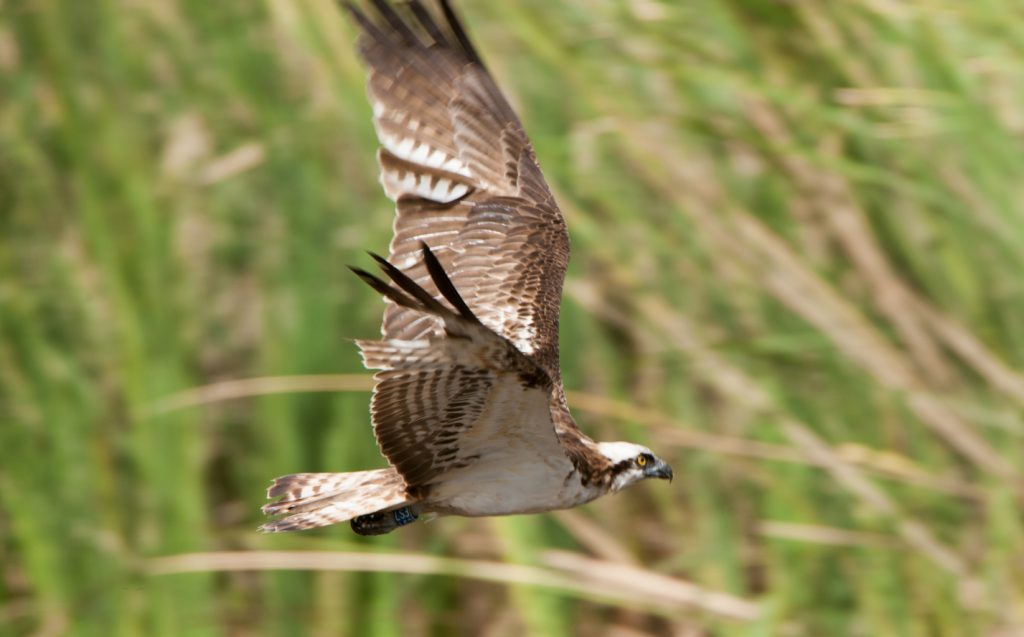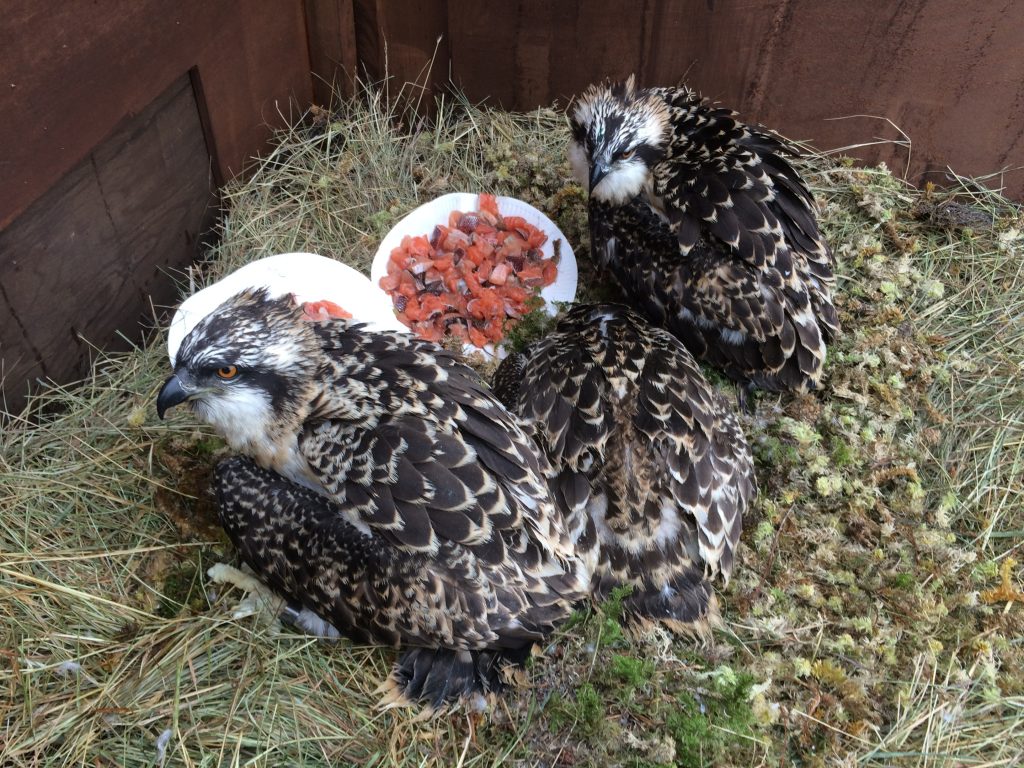The aim of the project is to help restore a South Coast breeding population of Osprey for the first time in over 200 years, and in doing so help fragmented populations across Western Europe to link up and expand. This project is part of the wider plan for the recovery and conservation of Osprey in Europe and the Mediterranean which was written by Roy Dennis on behalf of the Council of Europe and follows long-established techniques for the rearing and release of translocated Ospreys.
This summer, the team received fourteen new chicks from Scotland, which were collected under licence by the Roy Dennis Wildlife Foundation and delivered to the Poole project team on 11th July. The birds were kept in the same specially designed release pens as last year and fed the same diet of locally sourced fresh fish. All were fit and healthy and on 31st July and 1st August, the first five birds, 003, 007, 011, 013 and 014 were successfully released and quickly grew in confidence on the wing. A second release was planned for the following week.
On 5th August, two of the birds yet to be released began to show serious symptoms of ill health, including spasms and seizures, that were unfamiliar to the project team or its partners. We monitored both closely and sought veterinary advice. Then, during the night of 6th August, a third bird suddenly began to display identical symptoms and quickly and unexpectedly died. The deceased bird was taken straight to a veterinary specialist for a post-mortem at Cotswold Wildlife Park. The team there, led by Jamie Craig, have extensive knowledge of a wide range of different bird species and long-established links with highly experienced avian vets and other experts. As a precaution, the two ill birds were also taken to Cotswold Wildlife Park for intensive care.
A suggestion was that given the neurological symptoms we had observed, a possible cause was a thiamine (vitamin B1) deficiency. The birds were given a thiamine injection as a precaution, but various tests would be required to confirm the diagnosis.
In the meantime, four of the remaining birds, 002, 008, 010 and 012 were considered ready for release, which was undertaken on the morning of 7th August. As a precaution, vitamin supplements, that included thiamine, were added to the fish we provided twice daily for both the released birds and those still in the pens. Some 36 hours after it made its first flight, one of the released birds, 010, also began displaying symptoms of ill health. It was put back in one of the pens overnight but quickly deteriorated showing exactly the same symptoms as the other ill birds and died the following morning. Not long after this we also received news from the team at Cotswold that one of the birds we had taken into care two days previously had been found to have damage to its lower back and leg, potentially caused by the spasms, and the decision was made to euthanize it. Furthermore, another of the birds yet to be released, 004, had developed fast deteriorating symptoms overnight and it too died before it was possible for it to be assessed by the specialists. The last remaining bird in the pen, 006, which was not ready to fledge, was taken to the specialist vet as a precaution as it too began to show similar symptoms. It was given a thiamine injection on arrival but deteriorated over the course of the next 24 hours and also died.
In under a week we had lost five of our fourteen birds.
Then, on the evening of 8th August, we found that one of the first birds to be released, 003, which had been flying strongly, feeding well and exploring the further reaches of the harbour, had drowned after becoming tangled in dense weed on the shores of an island that is only accessible by boat. This was most probably unrelated to the deaths of the other birds, and a danger all young Ospreys face during their first weeks on the wing but given the events that had unfolded in the previous few days it was a severe blow.
The speed with which the young Ospreys had become ill and died was both shocking and devastating, not least because we are still unsure of what had caused their sudden deaths. The protocols we used this year are identical to those used in our successful first year and we are unaware of any similar mortality events occurring in any other Osprey translocation projects.
As a matter of urgency, we began running tests on our food and water supplies and re-evaluating our daily procedures. The pathology results from the lab ruled out a bacterial and viral infection, which was important as it meant the health of our free-flying birds would not be affected. Tests are on-going but with each of the deceased birds displaying identical symptoms prior to death, the specialists are all in agreement that a thiamine deficiency is almost certainly a main contributing factor.
Thiamine (Vitamin B1) is required for a basic cellular metabolism and is crucial in the development of young birds and animals. Blood tests have been conducted to see whether a thiamine deficiency in the birds is present and we hope to have the results from these tests back very soon.
This has been an incredibly tough week for all the project team, our volunteers and our partners. We will continue to test and assess our deceased birds to provide a clear set of data for a robust analysis.
Some encouraging news is that 005, one of the first birds we took for treatment at Cotswold Wildlife Park, is showing real signs of improvement. It was initially suffering from near paralysis in both legs, but thanks to the swift action of Jamie Craig and the team at Cotswold Wildlife Park, we think that the thiamine injection they gave it on arrival may have saved it. There is still a great deal of rehabilitation required, but it is encouraging that the bird is showing consistent signs of improvement. Interestingly, sixteen Herring Gulls, which were found alive but with paralysis on the Baltic Sea coast, recovered completely after being treated in a similar way, with birds that were not treated in this way all dying. (Balk et al., 2009). We hope that 005 will recover sufficiently to be released in time for migration.
A project of this scale and ambition will always face challenges: what is important is the manner with which we respond to and learn from such challenges and, crucially, how we use our expanded knowledge base to continue to strive for our overall objective. Other projects have faced similar challenges, including the first year of the Rutland Osprey translocation project when sadly four of their first eight birds died from Salmonella poisoning. Nonetheless, Rutland is now home to a well-established population following the first successful breeding attempt in 2001.
As with Rutland, valuable lessons have been, and are still being, learnt within our project. We are extremely proud of the perseverance and dedication of our team and everyone who has fought to help our birds over the past week. Despite this year’s setback with our project, we can still take heart in the fact that we have released another seven healthy Ospreys who are now out and enjoying Poole Harbour, and already mixing and interacting with migrant Ospreys that are currently passing through. We were also happy to hear that last winter three of last years released birds were photographed down in West Africa which is testament to the process we had in place last summer. We very much hope that 005 will be joining them again in a few weeks’ time. We remain determined to restore a population of these wonderful birds to the South Coast.
We hope to have more information over the coming days but in the meantime, we thank you for your patience and support. We also owe our sincere thanks to Jamie Craig, Emily Boyes and the team at Cotswold Wildlife Park for their incredible support and advice during this very difficult period.
The Poole Harbour Osprey Project Team.
References
Balk L, Hägerroth P-Å, Gustavsson H, Sigg L, Åkerman G, Hanson M, Tjärnlund U, Hansson T, Hallgrimsson GT, Zebühr Y, Broman D, Mörner T and Sundberg H. (2009) Wild birds of declining European species are dying from a thiamine deficiency syndrome. Proc. Natl. Acad. Sci. USA 106, 12001–12006
Balk L, Hägerroth P-Å, Gustavsson H, Sigg L, Åkerman G, Muñoz YR, Honeyfield DC, Tjärnlund U, Oliveira K, Ström K, McCormick SD, Karlsson S, Ström M, Manen M van, Berg A-L, Halldórsson HP, Strömquist J, Collier TK, Börjeson H, Mörner T, Hansson T (2016) Widespread episodic thiamine deficiency in Northern hemisphere wildlife. Sci Rep 6:38821. doi: 10.1038/srep38821



